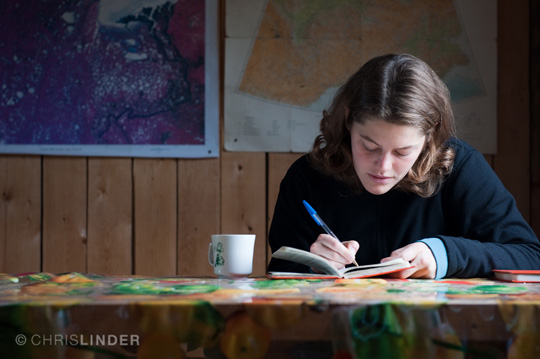Field Notes
During, before, and after the field course, Polaris students and faculty share their thoughts through journal entries.

During, before, and after the field course, Polaris students and faculty share their thoughts through journal entries.

Before I came to the tundra, I imagined it to be a vast, flat landscape. And it is indeed vast, but flat is the last word I would use to describe the tundra. The topography is dynamic, just on a very tiny scale.
Continue readingThe core students have been working hard in the field collecting, mapping, photographing, and measuring their plots, streams, and ponds. Now that we are into the last days of our time in the tundra the focus has turned toward extracting the numbers from the various samples.
Continue readingEven though mammoths are absent from the park, we still have a plethora of arctic megafauna influencing our sites. The animals leave signs of their presence in the form of hair, trails, browsed shrubs, and especially dung.
Continue readingTo test big ideas we need big minds and big spaces. That’s why just south of here the Zimovs created Pleistocene Park, a 16 square kilometer experiment in ecology and biogeochemistry.
Continue readingOnly a handful of returning students are still here at the North East Science Station. The Core and the rest of the students are up in the tundra, working on their projects. Although historically being sent to the tundra is a bad thing, I can’t help but feel a little
Continue readingIt is very exciting to watch the core students and listen to how their conversations and questions develop and evolve as they experience the tundra firsthand and receive insights from the faculty members. This team has shown a huge amount of support for each other and a high level of
Continue readingI want to understand how arctic ground squirrels are influencing carbon flux in the tundra. These little critters are one of many examples of wildlife that can affect the processes that affect climate change.
Continue readingThe barge is the central hub of life. The metal hull is about 30 meters long with a 10 meter flat deck in the bow where two tents sit. They are tied down by an ancient bison femur, a mammoth scapula and other bones we found on our travels.
Continue readingI thought I knew what I wanted to study, and how to do it. I needed water—a stream that ran from headwaters down through beaded pools and into an outlet. There were many of them around Cherskiy, but there were none near our mooring on the Kolyma River.
Continue readingMost scientists follow a path that leads them to becoming an expert in their field —just one aspect of scientific knowledge. Some people spend their time looking at plants while others may dedicate their days finding animal poop. Everyone has different interests and these interests drive scientific discovery. However, sometimes
Continue readingSince arriving in Cherskiy, everything has been fast paced, but I wouldn’t have it any other way.
Continue readingNext on the agenda is the tundra. The anticipation has been building for the past seven or so days to go to this mysterious place.
Continue readingAs a child I visited many parks and historical sites. At most of these parks the rangers always mentioned that there was a chance that you might find fossils, bones or artifacts as you walked along. Finding a fossil or preserved bone is something that I dreamed about every time
Continue readingThe first day out our group included Erika, Jessica, and Kenzie and we walked to the site known as Y3. This is where Dr. Heather Alexander has set up her studies on the effect of fire on the boreal forest.
Continue readingI drilled cores of permafrost, put sensors in the trees, made a census of animal traces (looking for poop), placed gas chambers in the ground to measure CO2 fluxes, swam in the Panteleikha, talked about ideas for my own project, saw an owl, and jammed on the barge until late
Continue reading